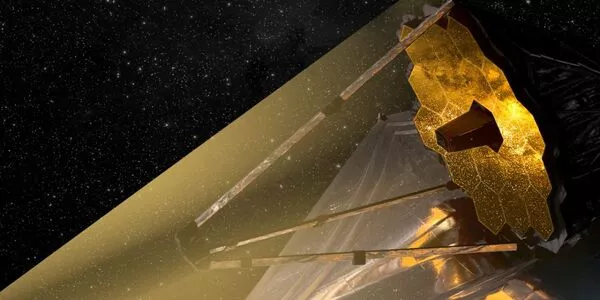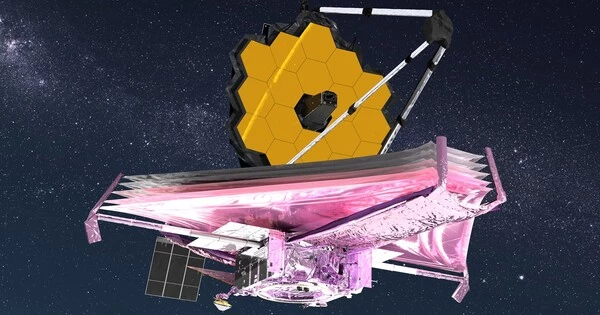Up on the monitor in the James Webb Space Telescope Flight Control Room is an image of the planet Jupiter. Although slightly blurred, it is unmistakable, its characteristic stripes and huge Great Red Spot beaming down on a group of reporters touring the room at the Space Telescope Science Institute in Baltimore.
Carl Starr, Webb’s Mission Operations Manager for the James Webb Space Telescope, clicks a computer mouse, and the next image appears. “We decided to apply the coronagraph to it,” he said, referring to a telescope attachment that can block out a bright object to observe what surrounds it. Jupiter suddenly darkens as its moons and faint rings materialize.
The images of Jupiter that Starr has shown the group are the last of a collection of unreleased test photos taken as part of the telescope’s alignment and calibration process. “So you see, these are just hot off the presses,” Starr said. “These images are raw images that haven’t been doctored, haven’t been cleaned up. But this is what the telescope is doing.”
NASA will release the first official images from Webb during a live broadcast held to mark the telescope’s transition into a fully active scientific instrument. But these striking test images are far from the last time the telescope will focus its gaze on Jupiter. In fact, Webb will soon turn its gaze on many objects in our own solar system. Although the telescope was built to observe distant galaxies, it will also allow scientists to observe our solar system in completely new ways.
“Webb is designed to be an incredibly powerful tool that will see out to the edge of the cosmos, the most distant galaxies, maybe even the first stars that formed,” Heidi Hammel, Vice President of the Association of Universities for Research in Astronomy and an interdisciplinary scientist working on Webb, told Space.com. “But because it is so powerful, it has capabilities that we can apply everywhere in the cosmos, even in our local neighborhood, the solar system.”
Webb is designed to be an incredibly powerful tool that will see out to the edge of the cosmos, the most distant galaxies, and maybe even the first stars that formed.
Heidi Hammel
In a new light
Although Webb was always meant to focus on the distant cosmos, scientists started scheming to use it to observe the solar system early on. In 2002, NASA chose Hammel to work on the mission as an interdisciplinary scientist, helping Webb’s various instrument teams develop plans to study the solar system.
Many of those plans rely on instruments called spectrographs. These instruments capture what scientists call spectra — representations of the different wavelengths of light emitted and absorbed by anything from a star to a planet’s atmosphere to interstellar dust. Because different substances emit and absorb light in distinctive ways, scientists have used spectrographs to find out what much of the universe is made of.
Webb is an infrared telescope, meaning its spectrographs detect wavelengths of light longer than the human eye can see, revealing details about what makes up the cosmos that observatories focusing on visible and ultraviolet spectra, including the venerable Hubble Space Telescope, cannot. Infrared capability is vital for gleaning details about faraway stars, but it also enables the observatory to investigate details of our solar system that have long eluded scientists.
“There is so much molecular chemistry that manifests itself in the infrared part of the spectrum,” Hammel said.
Other aspects of the telescope, most notably its unprecedented sensitivity, enable Webb to observe faint phenomena both near and far. And where telescopes on Earth struggle to examine objects close to something extremely bright, like Jupiter’s moons, Webb’s perch in deep space and the coronagraph Starr demonstrated give the observatory new power.
“With Earth-bound telescopes, the scattered light from Jupiter is spread out by the Earth’s atmosphere and contaminates a pretty large region,” Hammel said. With Webb, in contrast, “the light from Jupiter is going to be contained to Jupiter.”

To Jupiter and beyond
Scientists won’t wait long to turn Webb’s gaze on our solar system’s largest planet. Jupiter, as well as its moons and rings, is included in a program designed to broadly release data from the observatory’s first five months. The early cornucopia is meant to give scientists a chance to learn to use Webb’s data effectively.
From these observations, scientists hope to better understand Jupiter’s weather, temperature, composition and auroral activity — lights painted across the sky by charged particles from the sun hitting a planet’s atmosphere. The data will also help scientists to study Jupiter’s rings, how they might have formed, and where they might have come from.
Researchers will also try to map out plumes of vapor rising from two of Jupiter’s moons — volcano-covered Io and icy Ganymede. On Io, these come from its many volcanoes, but some evidence from Hubble suggests that another one of Jupiter’s icy moons, Europa, could spit out plumes of water vapor. (Europa isn’t alone: NASA’s Saturn explorer Cassini gathered clearer data suggesting plumes of water vapor and tiny grains of ice rising from the surface of that planet’s Enceladus.) Hammel said that in future research, scientists will use Webb to take spectra of the plumes on Europa and Enceladus in hopes of sniffing out what they are made of and whether they reveal any signs of life hiding in the ice-covered ocean.
Our solar system, far and wide
Of course, Webb won’t confine its solar system explorations to just planets. The telescope will examine much smaller objects like asteroids and comets, learning more about what they are made of and seeing some in greater detail than ever before. Webb is even ready to target any new comet that scientists might discover, Hammel said, through a program to respond to cosmic surprises that scientists couldn’t plan for when telescope time was allocated.
Other projects will target the Kuiper Belt, the icy “graveyard of the solar system.” Pluto, its moon Charon and thousands of other objects orbit the sun in this mysterious boundary zone of our solar system. Scientists believe that Kuiper Belt objects are left over from our solar system’s beginnings and could help explain how our neighborhood formed.
“These are objects that are in the graveyard of solar system formation,” Jonathan Lunine, an astronomer at Cornell University and a Webb interdisciplinary scientist like Hammel, said in a statement.
Other Webb science programs could bring insights to our solar system from beyond its boundaries. Scientists will study distant planetary systems in various stages of formation, perhaps shedding light on our own. Big-picture questions like where the universe’s water comes from would also have implications for the formation of planets like Earth.





